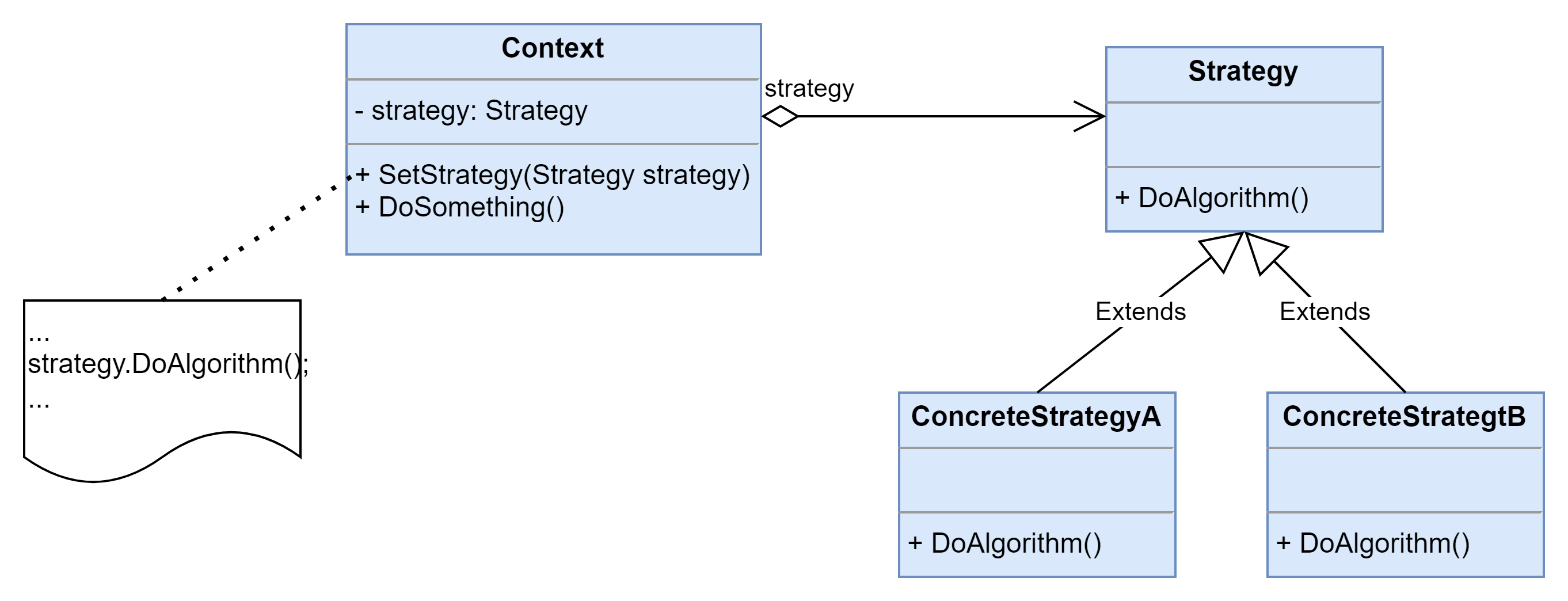策略模式 (Strategy Pattern) - 算法的封装与切换
定义一系列算法类,将每一个算法封装起来,并让它们可以相互替换,策略模式让算法独立于使用它的客户而变化,也称为政策模式(Policy)。策略模式是一种对象行为型模式。
结构图
- Context(环境类):环境类是使用算法的角色,它在解决某个问题(即实现某个方法)时可以采用多种策略。在环境类中维持一个对抽象策略类的引用实例,用于定义所采用的策略。
- Strategy(抽象策略类):它为所支持的算法声明了抽象方法,是所有策略类的父类,它可以是抽象类或具体类,也可以是接口。环境类通过抽象策略类中声明的方法在运行时调用具体策略类中实现的算法。
- ConcreteStrategy(具体策略类):它实现了在抽象策略类中声明的算法,在运行时,具体策略类将覆盖在环境类中定义的抽象策略类对象,使用一种具体的算法实现某个业务处理。
示例
using System;
using System.Collections.Generic;
namespace DesignPatterns.Strategy
{
// The Context defines the interface of interest to clients.
class Context
{
// The Context maintains a reference to one of the Strategy objects. The
// Context does not know the concrete class of a strategy. It should
// work with all strategies via the Strategy interface.
private IStrategy _strategy;
public Context()
{ }
// Usually, the Context accepts a strategy through the constructor, but
// also provides a setter to change it at runtime.
public Context(IStrategy strategy)
{
this._strategy = strategy;
}
// Usually, the Context allows replacing a Strategy object at runtime.
public void SetStrategy(IStrategy strategy)
{
this._strategy = strategy;
}
// The Context delegates some work to the Strategy object instead of
// implementing multiple versions of the algorithm on its own.
public void DoSomeBusinessLogic()
{
Console.WriteLine("Context: Sorting data using the strategy (not sure how it'll do it)");
var result = this._strategy.DoAlgorithm(new List<string> { "a", "b", "c", "d", "e" });
string resultStr = string.Empty;
foreach (var element in result as List<string>)
{
resultStr += element + ",";
}
Console.WriteLine(resultStr);
}
}
// The Strategy interface declares operations common to all supported
// versions of some algorithm.
//
// The Context uses this interface to call the algorithm defined by Concrete
// Strategies.
public interface IStrategy
{
object DoAlgorithm(object data);
}
// Concrete Strategies implement the algorithm while following the base
// Strategy interface. The interface makes them interchangeable in the
// Context.
class ConcreteStrategyA : IStrategy
{
public object DoAlgorithm(object data)
{
var list = data as List<string>;
list.Sort();
return list;
}
}
class ConcreteStrategyB : IStrategy
{
public object DoAlgorithm(object data)
{
var list = data as List<string>;
list.Sort();
list.Reverse();
return list;
}
}
class Program
{
static void Main(string[] args)
{
// The client code picks a concrete strategy and passes it to the
// context. The client should be aware of the differences between
// strategies in order to make the right choice.
var context = new Context();
Console.WriteLine("Client: Strategy is set to normal sorting.");
context.SetStrategy(new ConcreteStrategyA());
context.DoSomeBusinessLogic();
Console.WriteLine();
Console.WriteLine("Client: Strategy is set to reverse sorting.");
context.SetStrategy(new ConcreteStrategyB());
context.DoSomeBusinessLogic();
}
}
}运行结果
1
2
3
4
5
6
7
Client: Strategy is set to normal sorting.
Context: Sorting data using the strategy (not sure how it'll do it)
a,b,c,d,e
Client: Strategy is set to reverse sorting.
Context: Sorting data using the strategy (not sure how it'll do it)
e,d,c,b,a
总结
策略模式用于算法的自由切换和扩展,它是应用较为广泛的设计模式之一。策略模式对应于解决某一问题的一个算法族,允许用户从该算法族中任选一个算法来解决某一问题,同时可以方便地更换算法或者增加新的算法。只要涉及到算法的封装、复用和切换都可以考虑使用策略模式。
优点
- 策略模式提供了对“开闭原则”的完美支持,用户可以在不修改原有系统的基础上选择算法或行为,也可以灵活地增加新的算法或行为。
- 策略模式提供了管理相关的算法族的办法。策略类的等级结构定义了一个算法或行为族,恰当使用继承可以把公共的代码移到抽象策略类中,从而避免重复的代码。
- 策略模式提供了一种可以替换继承关系的办法。如果不使用策略模式,那么使用算法的环境类就可能会有一些子类,每一个子类提供一种不同的算法。但是,这样一来算法的使用就和算法本身混在一起,不符合“单一职责原则”,决定使用哪一种算法的逻辑和该算法本身混合在一起,从而不可能再独立演化;而且使用继承无法实现算法或行为在程序运行时的动态切换。
- 使用策略模式可以避免多重条件选择语句。多重条件选择语句不易维护,它把采取哪一种算法或行为的逻辑与算法或行为本身的实现逻辑混合在一起,将它们全部硬编码(Hard Coding)在一个庞大的多重条件选择语句中,比直接继承环境类的办法还要原始和落后。
- 策略模式提供了一种算法的复用机制,由于将算法单独提取出来封装在策略类中,因此不同的环境类可以方便地复用这些策略类。
缺点
- 客户端必须知道所有的策略类,并自行决定使用哪一个策略类。这就意味着客户端必须理解这些算法的区别,以便适时选择恰当的算法。换言之,策略模式只适用于客户端知道所有的算法或行为的情况。
- 策略模式将造成系统产生很多具体策略类,任何细小的变化都将导致系统要增加一个新的具体策略类。
- 无法同时在客户端使用多个策略类,也就是说,在使用策略模式时,客户端每次只能使用一个策略类,不支持使用一个策略类完成部分功能后再使用另一个策略类来完成剩余功能的情况。
适用场景
- 一个系统需要动态地在几种算法中选择一种,那么可以将这些算法封装到一个个的具体算法类中,而这些具体算法类都是一个抽象算法类的子类。换言之,这些具体算法类均有统一的接口,根据“里氏代换原则”和面向对象的多态性,客户端可以选择使用任何一个具体算法类,并只需要维持一个数据类型是抽象算法类的对象。
- 一个对象有很多的行为,如果不用恰当的模式,这些行为就只好使用多重条件选择语句来实现。此时,使用策略模式,把这些行为转移到相应的具体策略类里面,就可以避免使用难以维护的多重条件选择语句。
- 不希望客户端知道复杂的、与算法相关的数据结构,在具体策略类中封装算法与相关的数据结构,可以提高算法的保密性与安全性。
This post is licensed under CC BY 4.0 by the author.
